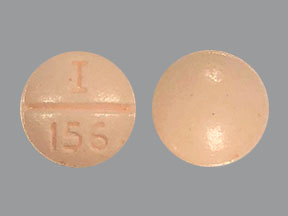
Propranolol Coupons & Savings Card – Discount Prices from $5.72
Generic for: Hemangeol
My prescription
Edit
10MG, Propranolol (60 Tablets)
Select pharmacy

CVS
$19.26
COUPON PRICE
Walmart
$5.72
COUPON PRICE
Albertsons
$10.41
COUPON PRICE
Walgreens
$12.14
COUPON PRICEPropranolol savings card
Show this card to your pharmacist
Walmart
$5.72
BIN
ID
PCN
GRP
019876
LHFA15F6C8
CHIPPO
LHX
Powered by
Related beta blockers prescriptions
More prescriptions for migraine
Related beta blockers prescriptions
More prescriptions for migraine
Price history for Hemangeol (brand) & Propranolol (generic)
60 Tablets, 10MG
Average retail price for Hemangeol
Average retail price for Propranolol
Average SaveHealth price for Propranolol
Our price history data is based on aggregated prescription data collected from participating pharmacies in America. Our prescription data updates daily to reflect the latest price changes. If you notice a missing data point, it means there wasn't sufficient data available to generate a monetary value for that date.
We analyzed Propranolol prices for (10MG, 60 Tablets) over the last 12 months. The average retail price was $46.42, while the average price using the SaveHealth discount card was $17.95. That's a savings of approximately 61.33% when using our Propranolol coupon.
Compared to the generic version, Hemangeol had an average price of $796.96 over the same time period. With the SaveHealth savings card, Propranolol is 97.75% cheaper on average than Hemangeol.
*Retail prices are based on pharmacy claims data, and may not be accurate when we don't have enough claims.
Propranolol dosage forms
Dosage Quantity Price from Per unit 10MG 60 Tablets $5.72 $0.10 10MG 1 Tablet $2.55 $2.55 10MG 3 Tablets $2.66 $0.89 10MG 30 Tablets $4.11 $0.14 10MG 33 Tablets $4.27 $0.13 10MG 40 Tablets $4.64 $0.12 10MG 50 Tablets $5.18 $0.10 10MG 90 Tablets $13.82 $0.15 10MG 100 Tablets $14.36 $0.14 10MG 120 Tablets $15.43 $0.13
| Dosage | Quantity | Price from | Per unit |
|---|---|---|---|
| 10MG | 60 Tablets | $5.72 | $0.10 |
| 10MG | 1 Tablet | $2.55 | $2.55 |
| 10MG | 3 Tablets | $2.66 | $0.89 |
| 10MG | 30 Tablets | $4.11 | $0.14 |
| 10MG | 33 Tablets | $4.27 | $0.13 |
| 10MG | 40 Tablets | $4.64 | $0.12 |
| 10MG | 50 Tablets | $5.18 | $0.10 |
| 10MG | 90 Tablets | $13.82 | $0.15 |
| 10MG | 100 Tablets | $14.36 | $0.14 |
| 10MG | 120 Tablets | $15.43 | $0.13 |
| 10MG | 180 Tablets | $27.41 | $0.15 |
| 10MG | 270 Tablets | $31.67 | $0.12 |
| 10MG | 1000 Tablets | $47.00 | $0.05 |
| 20MG | 1 Tablet | $2.56 | $2.56 |
| 20MG | 10 Tablets | $3.14 | $0.31 |
| 20MG | 12 Tablets | $3.26 | $0.27 |
| 20MG | 20 Tablets | $3.77 | $0.19 |
| 20MG | 30 Tablets | $4.41 | $0.15 |
| 20MG | 32 Tablets | $4.54 | $0.14 |
| 20MG | 45 Tablets | $5.37 | $0.12 |
| 20MG | 50 Tablets | $5.69 | $0.11 |
| 20MG | 60 Tablets | $6.32 | $0.10 |
| 20MG | 90 Tablets | $14.74 | $0.16 |
| 20MG | 100 Tablets | $15.37 | $0.15 |
| 20MG | 1000 Tablets | $47.00 | $0.05 |
| 40MG | 1 Tablet | $2.59 | $2.59 |
| 40MG | 30 Tablets | $5.28 | $0.18 |
| 40MG | 50 Tablets | $7.13 | $0.14 |
| 40MG | 60 Tablets | $8.05 | $0.13 |
| 40MG | 90 Tablets | $17.33 | $0.19 |
| 40MG | 100 Tablets | $18.26 | $0.18 |
| 40MG | 270 Tablets | $33.83 | $0.13 |
| 40MG | 1000 Tablets | $55.00 | $0.06 |
| 60MG | 100 Tablets | $30.10 | $0.30 |
| 60MG | 180 Tablets | $33.38 | $0.18 |
| 80MG | 60 Tablets | $16.24 | $0.27 |
| 80MG | 90 Tablets | $29.61 | $0.33 |
| 80MG | 100 Tablets | $31.90 | $0.32 |
| 80MG | 270 Tablets | $45.98 | $0.17 |
| 80MG | 500 Tablets | $63.00 | $0.13 |
Propranolol Warnings
It is crucial to handle the discontinuation of this medication with care, as stopping it abruptly can lead to serious health risks. Below are essential safety details and precautions you should be aware of:
Do Not Stop Abruptly: Avoid discontinuing this drug without consulting your healthcare provider, especially if you have heart conditions such as angina or coronary artery disease. Sudden cessation can worsen these conditions or increase the risk of a heart attack.
Gradual Dose Reduction: If your doctor advises stopping the medication, they will guide you on how to gradually reduce the dose. This is important to prevent adverse effects on your heart. During this period, it is also recommended to limit physical activity to reduce heart strain.
Emergency Symptoms: Seek immediate medical assistance if you experience symptoms like worsening chest pain, pressure in the chest, pain spreading to the jaw, neck, or arm, unusual sweating, trouble breathing, or an irregular heartbeat.
Heart Failure Risk: Individuals with heart failure should use this medication cautiously, as it can exacerbate symptoms. If you notice fluid build-up in your body or difficulty breathing, contact your healthcare provider promptly.
Blood Sugar Awareness: Propranolol can mask signs of low blood sugar, such as a fast heartbeat or tremors, especially if you are on diabetes medications. Sweating may be the only unaffected symptom. Discuss with your doctor how to properly monitor your blood sugar levels.
Thyroid Considerations: If you have hyperthyroidism, consult your healthcare provider before stopping propranolol. Sudden discontinuation may lead to a "thyroid storm," characterized by high fever, rapid heartbeat, and fainting.
Breathing Concerns: Propranolol may cause breathing difficulties, particularly in individuals with asthma or COPD. Inform your doctor of any existing lung issues before starting the medication.
Skin Reactions: Rarely, propranolol may cause serious skin rashes. Contact your healthcare provider immediately if you develop a severe rash.
Surgical Risks: If you are scheduled for surgery requiring anesthesia, inform your surgeon that you are taking propranolol, as it can affect heart rate during the procedure.
Contraindications: Do not use this medication if you experience:
- Cardiogenic shock
- Sinus bradycardia or heart block greater than the first degree
- Bronchial asthma
Always discuss any concerns or questions with your healthcare provider to ensure safe and effective use of this medication.
Propranolol Side Effects
Common side effects:
- dizziness
- lightheadedness
- tiredness
- feeling weak
- nausea
- vomiting
- stomach pain
- unusual dreams
Less common but important to monitor:
- changes in vision
- trouble sleeping
- cold hands and feet
Serious side effects:
- trouble breathing
- unusual tiredness
- swelling in the legs, ankles, or feet
- mental or mood changes
- numbness or tingling in the limbs
- very slow heartbeat
- increased thirst
- increased urination
- easy bruising or bleeding
- signs of infection (persistent sore throat or fever)
- rash
- severe dizziness
- trouble breathing
- swelling of the face, tongue, or throat
Propranolol Interactions
Interactions with high risk of serious adverse effects and should be avoided:
Interactions with moderate risk that may require dose adjustment, closer monitoring, or timing changes:
- Epinephrine
- Fingolimod
- Quinidine
- Rifamycins
- Fezolinetant
- Propafenone
- Verapamil
Interactions with low risk that usually do not require a change in therapy:
